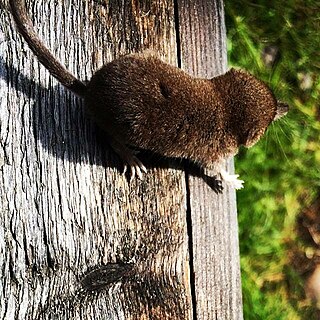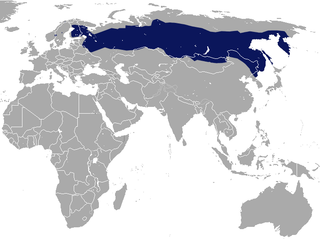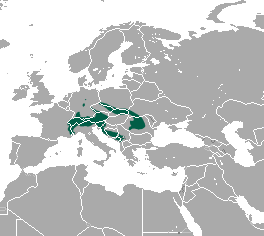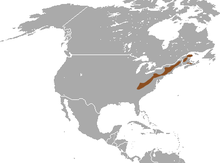
The cinereus shrew or masked shrew is a small shrew found in Alaska, Canada, and the northern United States. This is the most widely distributed shrew in North America, where it is also known as the common shrew.

The Arctic shrew, also known as the blackback shrew or saddlebacked shrew, is a medium-sized shrew found in Canada and the northern United States. Separate species status has been proposed for the maritime shrew which is found in New Brunswick and Nova Scotia and had been considered to be a subspecies of the Arctic shrew. The tundra shrew was formerly considered to be a subspecies of the Arctic shrew.

The American water shrew or northern water shrew, is a shrew found in the nearctic faunal region located throughout the mountain ranges of the northern United States and in Canada and Alaska. The organism resides in semi-aquatic habitats, and is known for being the smallest mammalian diver.

The marsh shrew, also known as the Pacific water shrew, Bendire's water shrew, Bendire's shrew and Jesus shrew is the largest North American member of the genus Sorex. Primarily covered in dark-brown fur, it is found near aquatic habitats along the Pacific coast from southern British Columbia to northern California. With air trapped in its fur for buoyancy, marsh shrews can run for three to five seconds on top of the water. It measures about 16 cm (6.3 in) in length, including a 7-centimetre (2.8 in)-long tail, and weighs an average of 14.5–16 g (0.51–0.56 oz). The marsh shrew's diet consists mainly of invertebrates, which it hunts on land and in the water. They are rare; their populations are thought to be in decline, and they are considered endangered in parts of their range.

The smoky shrew is a medium-sized North American shrew found in eastern Canada and the northeastern United States and extends further south along the Appalachian Mountains.

The vagrant shrew, also known as the wandering shrew, is a medium-sized North American shrew. At one time, the montane shrew and the Orizaba long-tailed shrew were considered to belong to the same species.

The genus Sorex includes many of the common shrews of Eurasia and North America, and contains at least 142 known species and subspecies. Members of this genus, known as long-tailed shrews, are the only members of the tribe Soricini of the subfamily Soricinae. They have 32 teeth.

The tundra shrew is a small shrew found in Alaska, the northern Yukon Territory, the MacKenzie Delta region of the Northwest Territories, extreme northwestern British Columbia and eastern Russia. At one time, this animal was considered to be a subspecies of the Arctic shrew.

The Gansu shrew is a red-toothed shrew found only in a small part of Gansu province and other adjacent areas of China. With its very limited range, it is sensitive to habitat loss and is listed as a "vulnerable species" in the Chinese Red List, while the IUCN lists it as being "data deficient"

Laxmann's shrew, or the masked shrew, is a species of shrew. Its range extends from northern Scandinavia and the Baltic to the Sea of Japan, including Hokkaidō, Sakhalin, and the Korean Peninsula. It favours mountain forests but is sometimes found in tundra and moorland, and also in lowland areas as well. It avoids cultivated land.

The Ussuri shrew, also known as the giant shrew, is a species of shrew found in Northeast Asia. An adult Ussuri shrew has a total length including the tail of 137 to 170 mm. It is found in valleys and on the forested slopes of mountains in the Korean Peninsula, northeastern China, and the Russian Far East. It is rarely observed, and its ecology is largely unknown.

The taiga shrew, also known as the even-toothed shrew can achieve a body length of about 67 millimeters, with a tail of about 43 millimeters. This shrew is very similar to the long-clawed shrew. This species inhabits forested mountain valleys, and is found across northern Eurasia. It ranges from the Baltic Sea area through the Lake Baikal region of Siberia into the Russian Far East and along the Baekdudaegan mountains of the Korean Peninsula.

Sorex ornatus sinuosus, the Suisun shrew or Suisun ornate shrew, is a subspecies of the ornate shrew that occurs in the tidal marshes of the northern shores of San Pablo and Suisun bays. Brown and Rudd redefined the western boundary of the range from a prior designation of the Petaluma River. The Suisun shrew has been designated as a Species of Concern by the U.S. government and a Mammalian Species of Special Concern by the state of California.

The African giant shrew is a species of white-toothed shrew. It also is known as, Mann's musk shrew, Euchareena's musk shrew, or Olivier's shrew. It is native to Africa, where it has a widespread distribution and occurs in many types of habitat. Its natural habitats are subtropical or tropical dry forest, subtropical or tropical moist lowland forest, subtropical or tropical moist montane forest, dry savanna, moist savanna, arable land, rural gardens, urban areas, and heavily degraded former forest. In the Nile Valley it is found near human habitation, where it is considered to be a pest. It is a common species and is listed by the International Union for Conservation of Nature as being of "least concern".

The alpine shrew is a species of mammal in the family Soricidae. It is found in the alpine meadows and coniferous forests of central and southern European mountain ranges.

The Arizona shrew is a species of shrew native to North America.

The large-toothed shrew or Mexican large-toothed shrew is one of 77 species within the genus Sorex. Registered on the IUCN Red List as vulnerable with a decreasing population, the Mexican large-toothed shrew has been recorded only 14 times in seven locations. The shrew is a member of the red-toothed shrew subfamily Soricinae, and the more taxonomically defined tribe Soricini. Members of the latter category exhibit long tails relative to body size.

The ornate shrew is a species of mammal in the family Soricidae (shrews). It is endemic to western North America, ranging from Northern California in the United States to Baja California in Mexico. Eight subspecies are known, including the extinct tule shrew, known only from four specimens collected in 1905, and the Suisun ornate shrew, a species of conservation concern in California. Through skull morphology research and genetic testing on Ornate shrew populations, it has been shown that there are three main genetic subdivisions: The Southern, Central and Northern. These three genetic subdivisions of Ornate shrew arose from populations of Ornate shrews getting geographically isolated from other populations.

Preble's shrew is a small shrew distributed across the Great Basin of the United States and southern British Columbia in Canada. It belongs to the order Eulipotyphla, family Soricidae and genus Sorex.

The Inyo shrew is a species of shrew found in the western United States. It is light gray and white in color, with a narrow skull and small body size, very similar in appearance to the related dwarf shrew, but paler and not as large. It can be found in many different habitats, from rocky, mountainous regions to wetlands and riparian areas. Not much is known about its behavioral and reproductive habits. While barely studied, their population is believed to be stable and not under any threat.




















